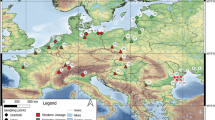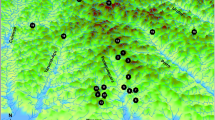Abstract
Crayfishes reach their peak biodiversity in North America, with the Mobile Basin of the southeastern US harboring high levels of endemism. However, the genetic diversity and phylogeography of crayfishes from this region are poorly understood. Here, the genetic structure and shape variation among multiple populations of Cambarus englishi Hobbs and Halland Cambarus halli Hobbs, both endemic to the Tallapoosa River, were examined from three catchments of the drainage (Upper, Little, and Middle) using mitochondrial cytochrome c oxidase subunit I (COI) gene sequences and geometric morphometrics. Notably, a combined COI network analysis found haplotypes from each species coalescing into common networks based on catchment, with significant genetic differentiation being identified between nearly all populations. Geometric morphometric analyses largely agreed with genetic analyses, with shape overlap yet significant differences between species and between the three catchments for C. halli (but not C. englishi). Together this suggests that genetic separation is manifested in part by shape variation and overall, these crayfishes appear to represent “cryptic species complexes.” Our data provide evidence for the establishment of evolutionarily significant units along the Upper, Little, and Middle Tallapoosa and that there is considerable population isolation and cryptic diversity within North American crayfishes.







Similar content being viewed by others
References
Bentley, A. I., D. J. Schmidt & J. M. Hughes, 2010. Extensive intraspecific genetic diversity of a freshwater crayfish in a biodiversity hotspot. Freshwater Biology 55: 1861–1873.
Bergman, D. A. & P. A. Moore, 2003. Field observations of intraspecific agonistic behavior of two crayfish species, Orconectes rusticus and Orconectes virilis, in different habitats. The Biological Bulletin 205: 26–35.
Bohonak, A. J., 1999. Dispersal, gene flow, and population structure. The Quartely Review of Biology 74: 21–45.
Bovbjerg, R. V., 1959. Density and dispersal in laboratory crayfish populations. Ecology 40: 504–506.
Brogden, S. M., C. R. Tabit & L. G. Kral, 2003. Population structure of the Tallapoosa darter (Etheostoma tallapoosae). Southeastern Naturalist 2: 487–498.
Bubb, D. H., T. J. Thom & M. C. Lucas, 2006. Movement, dispersal and refuge use of co-occurring introduced and native crayfish. Freshwater Biology 51: 1359–1368.
Buhay, J. E., 2009. “COI-like” sequences are becoming problematic in molecular systematic and DNA barcoding studies. Journal of Crustacean Biology 29: 96–110.
Clement, M., D. Posada & K. A. Crandall, 2000. TCS: a computer program to estimate gene genealogies. Molecular Ecology 9: 1657–1659.
Coffroth, M. A., H. R. Lasker, M. E. Diamond, J. A. Bruenn & E. Bermingham, 1992. DNA fingerprinting of a gorgonian coral: a method for detecting clonal structure in a vegetative species. Marine Biology 114: 317–325.
Connelly, H. M., C. R. Tabit & L. G. Kral, 2006. Population structure of the Tallapoosa shiner (Cyprinella gibbsi) and the Tallapoosa darter (Etheostoma tallapoosae). Southeastern Naturalist 5: 85–92.
Cook, B. D., A. M. Baker, T. J. Page, S. C. Grant, J. H. Fawcett, D. A. Hurwood & J. M. Hughes, 2006. Biogeographic history of an Australian freshwater shrimp, Paratya australiensis(Atyidae): the role of life history transition in phylogeographic diversification. Molecular Ecology 15: 1083–1093.
Costa, F. O., J. R. deWaard, J. Boutillier, S. Ratnasingham, R. Dooh, M. Hajibabaei & P. D. N. Hebert, 2007. Biological identifications through DNA barcodes: the case of the Crustacea. Canadian Journal of Fisheries and Aquatic Sciences 64: 272–295.
Crandall, K. A., A. R. Templeton & C. F. Sing, 1994. Intraspecific phylgenetics: problems and solutions. In Scotland, R. W., D. J. Siebert & D. M. Williams (eds), Models in Phylogeny Reconstruction. Clarendon, Oxford, UK: 273–297.
Creed, R. P., 1994. Direct and indirect effects of crayfish grazing in a stream community. Ecology 75: 2091–2103.
Davis, K. M. & R. Huber, 2007. Activity patterns, behavioural repertoires, and agonistic interactions of crayfish: a non-manipulative field study. Behaviour 144: 229–247.
de Oliveira, L. R., J. I. Hoffman, E. Hingst-Zaher, P. Majlf, M. C. Muelbert, J. S. Morgante & W. Amos, 2008. Morphological and genetic evidence for two evolutionarily significant units (ESUs) in the South American fur seal, Arctocephalus gazelle. Conservation Genetics 9: 1451–1466.
Dennard, S., J. T. Peterson & E. S. Hawthorne, 2009. Life history and ecology of Cambarus halli (Hobbs). Southeastern Naturalist 8: 479–494.
Dorn, N. J., 2013. Consumptive effects of crayfish limit snail populations. Freshwater Science 32: 1298–1308.
Excoffier, L., P. E. Smouse & J. M. Quattro, 1992. Analysis of molecular variance inferred from metric distances among DNA haplotypes: application to human mitochondrial restriction data. Genetics 131: 479–491.
Excoffier, L., G. Laval & S. Schneider, 2005. Arlequin (version 3.0): An integrated software package for population genetics data analysis. Evolutionary Bioinformatics Online 1: 47–50.
Fero, K. & P. A. Moore, 2008. Social spacing of crayfish in natural habitats: what role does dominance play? Behavioral Ecology and Sociobiology 62: 1119–1125.
Fluker, B. L., B. R. Kuhajda & P. M. Harris, 2014. The effects of riverine impoundment on genetic structure and gene flow in two stream fishes in the Mobile River basin. Freshwater Biology 59: 526–543.
Folmer, O., M. Black, W. Hoeh, R. Lutz & R. Vrijenhoek, 1994. DNA primers for amplification of mitochondrial cytochrome c oxidase subunit I from diverse metazoan invertebrates. Molecular Marine Biology and Biotechnology 3: 294–299.
Fu, Y., 1997. Statistical tests of neutrality of mutations against population growth, hitchhiking and background selection. Genetics 147: 915–925.
Helms, B., Z. J. Loughman, B. L. Brown & J. Stoeckel, 2013. Recent advances in crayfish biology, ecology, and conservation. Freshwater Science 32: 1273–1275.
Hobbs Jr, H. H., 1981. The crayfishes of Georgia. Smithsonian Contributions to Zoology 318: 1–549.
Hughes, J. M., D. J. Schmidt & D. S. Finn, 2009. Genes in streams: using DNA to understand the movement of freshwater fauna and their riverine habitat. BioScience 59: 573–583.
Irwin, E. R. & M. C. Freeman, 2002. Proposal for adaptive management to conserve biotic integrity in a regulated segment of the Tallapoosa River, Alabama, U.S.A. Conservation Biology 16: 1212–1222.
Klingenberg, C. P., 2011. MorphoJ: an integrated software package for geometric morphometrics. Molecular Ecology Resources. 11: 353–357.
Larson, E. R., C. L. Abbtt, N. Usio, N. Azuma, K. A. Wood, L.-M. Herborg & J. D. Olden, 2012. The signal crayfish is not a single species: cryptic diversity and invasions in the Pacific Northwest range of Pacifasticus leniusculus. Freshwater Biology 57: 1823–1838.
Loughman, Z. J. & S. A. Welsh, 2010. Distribution and conservation standing of West Virginia crayfishes. Southeastern Naturalist 9: 63–78.
Lydeard, C. & R. L. Mayden, 1995. A diverse and endangered aquatic ecosystem of the southeast United States. Conservation Biology 9: 800–805.
Mathews, L. M., L. Adams, E. Anderson, M. Basile, E. Gottardi & M. Buckholt, 2008. Genetic and morphological evidence for substantial hidden biodiversity in a freshwater crayfish species complex. Molecular Phylogenetics and Evolution 48: 126–135.
Momot, W. T., 1995. Redefining the role of crayfish in aquatic ecosystems. Reviews in Fisheries Science 3: 33–63.
Moore, M. J., R. J. DiStefano & E. R. Larson, 2013. An assessment of life-history studies for USA and Canadian crayfishes: identifying biases and knowledge gaps to improve conservation and management. Freshwater Scinece 32: 1276–1287.
Nei, M., 1987. Molecular evolutionary genetics. Columbia University Press, New York.
Neville, H. M., J. B. Dunham & M. M. Peacock, 2006. Landscape attributes and life history variability shape genetic structure of trout populations in a stream network. Landscape Ecology 21: 901–916.
Peeke, H. V. S., J. Sippell & M. H. Figler, 1995. Prior residence effects in shelter defense in adult Signal Crayfish (Pacifasticus leniusculus (Dana)): results in same- and mixed-sex dyads. Crustaceana 68: 873–881.
Perry, W. L., A. M. Jacks, D. Fiorenza, M. Young, R. Kuhnke & S. J. Jacquemin, 2013. Effects of water velocity on the size and shape of rusty crayfish, Orconectes rusticus. Freshwater Science 32: 1398–1409.
Posada, D. & K. A. Crandall, 1998. MODELTEST: testing the model of DNA substitution. Bioinformatics 14: 817–818.
Pringle, C. M., M. C. Freeman & B. J. Freeman, 2000. Regional effects of hydrologic alterations on riverine macrobiota in the New World: tropical–temperate comparisons. BioScience 50: 807–823.
Rabeni, C. F., 1992. Trophic linkage between stream centrarchids and their crayfish prey. Canadian Journal of Fisheries and Aquatic Sciences 49: 1714–1721.
Rabeni, C. F., K. J. Collier, S. M. Parkyn & B. J. Hicks, 1997. Evaluating techniques for sampling stream crayfish (Paranephrops planifrons). New Zealand journal of marine and freshwater research 31: 693–700.
Ray, N., M. Currat & L. Excoffier, 2003. Intra-deme molecular diversity in spatially expanding populations. Molecular Biological Evolution 20: 76–86.
Ricciardi, A. & J. B. Rasmussen, 1999. Extinction rates of North American freshwater fauna. Conservation Biology 13: 1220–1222.
Rohlf, J., 2013. Tpsdig 2 (ver 2.17). Available at http://life.bio.sunysb.edu/morph/.
Santos, S. R., 2006. Patterns of genetic connectivity among anchialine habitats: a case study of the endemic Hawaiian shrimp Halocaridina rubra on the Island of Hawaii. Molecular Ecology 15: 2699–2718.
Simmons, J. W. & S. J. Fraley, 2010. Distribution, status, and life-history observations of crayfishes in western North Carolina. Southeastern Naturalist 9: 79–126.
Slatkin, M., 1987. Gene flow and the geographic structure of natural populations. Science 15: 787–792.
Smith, J. B., G. A. Schuster, C. A. Taylor, E. A. Wynn, & S. W. McGregor, 2011. A preliminary report on the distribution and conservation status of the Alabama crayfish fauna. Geological Survey of Alabama Open-File Report 1102.
Stephens, J. D., S. R. Santos & D. R. Folkerts, 2011. Genetic differentiation, structure, and a transition zone among populations of the pitcher plant moth Exyra semicrocea: implications for conservation. PLoS ONE 6(7): e22658. doi:10.1371/journal.pone.0022658.
Tajima, F., 1989. Statistical method for testing the neutral mutation hypothesis by DNA polymorphism. Genetics 123: 585–595.
Tamura, K. & M. Nei, 1993. Estimation of the number of nucleotide substitutions in the control region of mitochondrial DNA in humans and chimpanzees. Molecular Biology and Evolution 10: 512–526.
Taylor, C. A., G. A. Schuster, J. E. Cooper, R. J. DiStefano, A. G. Eversole, P. Hamr, H. H. Hobbs III, H. W. Robinson, C. E. Skelton & R. R. Thoma, 2007. A reassessment of the conservation status of crayfishes of the United States and Canada after 10+ years of increased awareness. Fisheries 32: 372–389.
Taylor, C. A., S. B. Adams & G. A. Schuster, 2013. Systematics and biogeography of Orconectes, subgenus Trisellescens, in the southeastern United States, a test of morphology-based classification. Journal of Crustacean Biology 34: 1–14.
Templeton, A. R., K. A. Crandall & C. F. Sing, 1992. A cladistics analysis of phenotypic associations with haplotypes inferred from restriction endonucleases mapping and DNA sequence data. III. Cladogram estimation. Genetics 132: 619–633.
Williams, J. D., A. E. Bogan & J. T. Garner, 2008. Freshwater Mussels of Alabama and the Mobile Basin in Georgia, Mississippi, and Tennessee. University of Alabama Press, Tuscaloosa.
Zelditch, M. L., D. L. Swiderski & H. D. Sheets, 2012. Geometric Morphometrics for Biologists: a Primer, 2nd ed. Academic, San Diego, California.
Acknowledgments
We thank T. Hess, M. Clay, M. Schmid, C. Ames, A. Kelly, B. Williams, L. Tolley-Jordan, D. Donegan, and K. Kocot for their assistance in sampling and collecting data, and G. Schuster and C. Skelton for taxonomic verification of specimens. Funding for this study was provided by a Section 6 Grant from the Alabama Department of Conservation and Natural Resources. Two anonymous reviewers provided comments that improved the manuscript. This represents contribution #704 to the Auburn University Natural History Museum and #34 to the Molette Biology Laboratory for Environmental and Climate Change Studies.
Author information
Authors and Affiliations
Corresponding author
Additional information
Handling editor: Christian Sturmbauer
Electronic supplementary material
Below is the link to the electronic supplementary material.
Rights and permissions
About this article
Cite this article
Helms, B.S., Vaught, R.C., Suciu, S.K. et al. Cryptic diversity within two endemic crayfish species of the Southeastern US revealed by molecular genetics and geometric morphometrics. Hydrobiologia 755, 283–298 (2015). https://doi.org/10.1007/s10750-015-2311-4
Received:
Revised:
Accepted:
Published:
Issue Date:
DOI: https://doi.org/10.1007/s10750-015-2311-4




